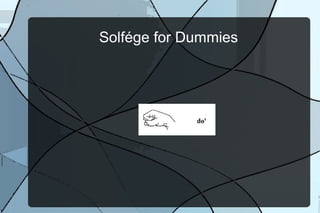Solfege for Dummies
•Download as ODP, PDF•
1 like•4,178 views
The basics of syllables and hand-signs for solfege.
Report
Share
Report
Share

Recommended
Recommended
More Related Content
What's hot
What's hot (20)
THE BASIC RUDIMENTS OF MUSIC. An introduction to notation

THE BASIC RUDIMENTS OF MUSIC. An introduction to notation
Similar to Solfege for Dummies
Similar to Solfege for Dummies (20)
Curso Canto Gregoriano - Tutorial In Gregorian Chant

Curso Canto Gregoriano - Tutorial In Gregorian Chant
More from jimusik
More from jimusik (7)
Recently uploaded
Mehran University Newsletter is a Quarterly Publication from Public Relations OfficeMehran University Newsletter Vol-X, Issue-I, 2024

Mehran University Newsletter Vol-X, Issue-I, 2024Mehran University of Engineering & Technology, Jamshoro
APM Welcome
Tuesday 30 April 2024
APM North West Network Conference, Synergies Across Sectors
Presented by:
Professor Adam Boddison OBE, Chief Executive Officer, APM
Conference overview:
https://www.apm.org.uk/community/apm-north-west-branch-conference/
Content description:
APM welcome from CEO
The main conference objective was to promote the Project Management profession with interaction between project practitioners, APM Corporate members, current project management students, academia and all who have an interest in projects.APM Welcome, APM North West Network Conference, Synergies Across Sectors

APM Welcome, APM North West Network Conference, Synergies Across SectorsAssociation for Project Management
Recently uploaded (20)
APM Welcome, APM North West Network Conference, Synergies Across Sectors

APM Welcome, APM North West Network Conference, Synergies Across Sectors
Beyond the EU: DORA and NIS 2 Directive's Global Impact

Beyond the EU: DORA and NIS 2 Directive's Global Impact
Ecological Succession. ( ECOSYSTEM, B. Pharmacy, 1st Year, Sem-II, Environmen...

Ecological Succession. ( ECOSYSTEM, B. Pharmacy, 1st Year, Sem-II, Environmen...
Presentation by Andreas Schleicher Tackling the School Absenteeism Crisis 30 ...

Presentation by Andreas Schleicher Tackling the School Absenteeism Crisis 30 ...
Mixin Classes in Odoo 17 How to Extend Models Using Mixin Classes

Mixin Classes in Odoo 17 How to Extend Models Using Mixin Classes
Solfege for Dummies
- 2. solfége – solfeggio – sol-fa These terms define a musical method used to teach sight-singing. The reason it is so widely used is its ability to cover the full spectrum of learning styles. By labeling each note of a scale with a syllable and hand- sign we cover the visual, auditory and kinesthetic levels all at the same time. The term Solfége is believed to come from two syllables in the scale, Sol and Fa. To “Sol-fa” something was to sing a passage of music in solfége. The widespread use of Solfége in Music Education is connected with Zoltán Kodály who created the Kodály Method in Hungary in the early 20th century.
- 3. Do is the starting note of the scale. You begin by showing the hand-sign at about the level of your belly-button.
- 4. Re is the note just above Do (one whole-step). This sign is displayed just slightly higher than Do.
- 5. Mi is the next note above Re (one whole-step). This is displayed just slightly higher than Re (typically about the level of your heart).
- 6. Mi to Fa is the first half-step we encounter. The hand sign simply turns the flattened hand for Mi down so the thumb is pointing to the ground.
- 7. So (or Sol) is the 5th degree of the scale (one whole-step above Fa). The hand position should be just about the level of you chin.
- 8. La (whole-step above So) is one of the more ambiguous hand-signs. It can be shown with all fingers pointing down and the top of the hand arched or just the thumb and index fingers pointing down with the other three curled under. The key is the top of the hand is arched from the wrist distinguishing it from the other hand-signs.
- 9. Ti is the whole-step above La. This is the 7th degree of the scale and always leads up to Do (hence the finger pointing up). The hand-sign is typically eye level.
- 10. Note: the upper Do' is distinguished from Do by using an apostrophe. The return to Do from Ti ends the major scale and the hand-sign is typically just about forehead level.
- 11. Here are the signs listed from bottom to top. The initial Do starts around the belly-button and Do' ends at the forehead. Note the two half-steps in the scale are indicated with a finger pointing the direction that note wants to lead (hence the term leading tone). Fa to Mi – Third and fourth degrees of the scale. Ti to Do – Seventh and eighth degrees of the scale.